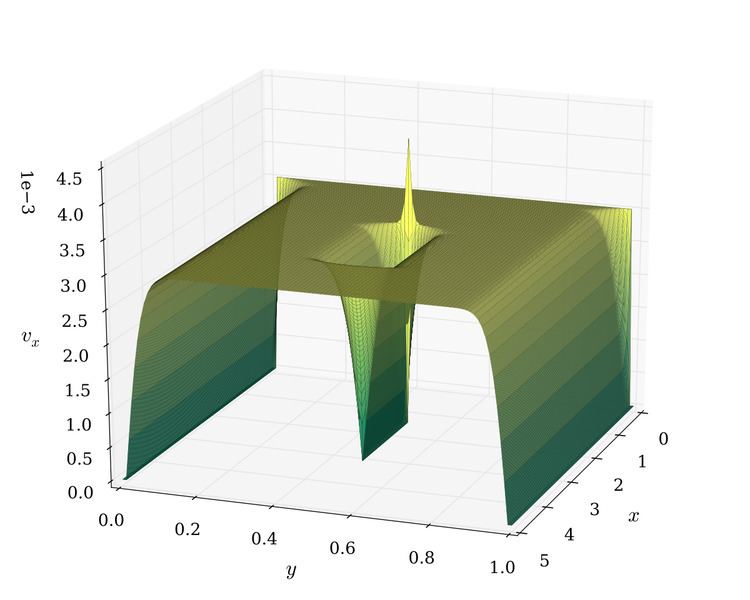 | ||
In numerical mathematics, the gradient discretisation method (GDM) is a framework which contains classical and recent numerical schemes for diffusion problems of various kinds: linear or non-linear, steady-state or time-dependent. The schemes may be conforming or non-conforming, and may rely on very general polygonal or polyhedral meshes (or may even be meshless).
Contents
- The example of a linear diffusion problem
- The core properties allowing for the convergence of a GDM
- Coercivity
- GD consistency
- Limit conformity
- Compactness needed for some nonlinear problems
- Piecewise constant reconstruction needed for some nonlinear problems
- Some non linear problems with complete convergence proofs of the GDM
- Nonlinear stationary diffusion problems
- p Laplace problem for p 1
- Linear and nonlinear heat equation
- Degenerate parabolic problems
- Review of some numerical methods which are GDM
- Galerkin methods and conforming finite element methods
- Nonconforming P1 finite element
- Mixed finite element
- Mimetic finite difference method and nodal mimetic finite difference method
- References
Some core properties are required to prove the convergence of a GDM. These core properties enable complete proofs of convergence of the GDM for elliptic and parabolic problems, linear or non-linear. For linear problems, stationary or transient, error estimates can be established based on three indicators specific to the GDM (the quantities
Any scheme entering the GDM framework is then known to converge on all these problems. This applies in particular to conforming Finite Elements, Raviart—Thomas Mixed Finite Elements, the
The example of a linear diffusion problem
Let us consider Poisson's equation in a bounded open domain
where
In a nutshell, the GDM for such a model consists in selecting a finite-dimensional space and two reconstruction operators (one for the functions, one for the gradients) and to substitute these discrete elements in lieu of the continuous elements in (2). More precisely, the GDM starts by defining a Gradient Discretization (GD), which is a triplet
The related Gradient Scheme for the approximation of (2) is given by: find
The GDM is then in this case a nonconforming method for the approximation of (2), which includes the nonconforming finite element method. Note that the reciprocal is not true, in the sense that the GDM framework includes methods such that the function
The following error estimate, inspired by [Strang,1972], holds
and
defining:
which measures the coercivity (discrete Poincaré constant),
which measures the interpolation error,
which measures the defect of conformity.
Then the core properties which are sufficient for the convergence of the method are, for a family of GDs, the coercivity, the GD-consistency and the limit-conformity properties, as defined in the next section. These three core properties are sufficient to prove the convergence of the GDM for linear problems. For nonlinear problems (nonlinear diffusion, degenerate parabolic problems...), we add in the next section two other core properties which may be required.
The core properties allowing for the convergence of a GDM
Let
Coercivity
The sequence
GD-consistency
For all
Limit-conformity
For all
Compactness (needed for some nonlinear problems)
For all sequence
Piecewise constant reconstruction (needed for some nonlinear problems)
Let
Some non-linear problems with complete convergence proofs of the GDM
We review some problems for which the GDM can be proved to converge when the above core properties are satisfied.
Nonlinear stationary diffusion problems
In this case, the GDM converges under the coercivity, GD-consistency, limit-conformity and compactness properties.
p-Laplace problem for p > 1
In this case, the core properties must be written, replacing
Linear and nonlinear heat equation
In this case, the GDM converges under the coercivity, GD-consistency (adapted to space-time problems), limit-conformity and compactness (for the nonlinear case) properties.
Degenerate parabolic problems
Assume that
Note that, for this problem, the piecewise constant reconstruction property is needed, in addition to the coercivity, GD-consistency (adapted to space-time problems), limit-conformity and compactness properties.
Review of some numerical methods which are GDM
All the methods below satisfy the first four core properties of GDM (coercivity, GD-consistency, limit-conformity, compactness), and in some cases the fifth one (piecewise constant reconstruction).
Galerkin methods and conforming finite element methods
Let
In this case,
The "mass-lumped"
Nonconforming P1 finite element
On a mesh
Mixed finite element
The mixed finite element method consists in defining two discrete spaces, one for the approximation of
Mimetic finite difference method and nodal mimetic finite difference method
This family of methods is introduced by [Brezzi et al, 2005] and completed in [Lipnikov et al, 2014]. It allows the approximation of elliptic problems using a large class of polyhedral meshes. The proof that it enters the GDM framework is done in [Droniou et al, 2013].
